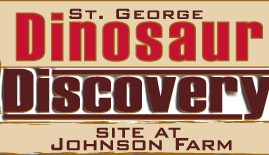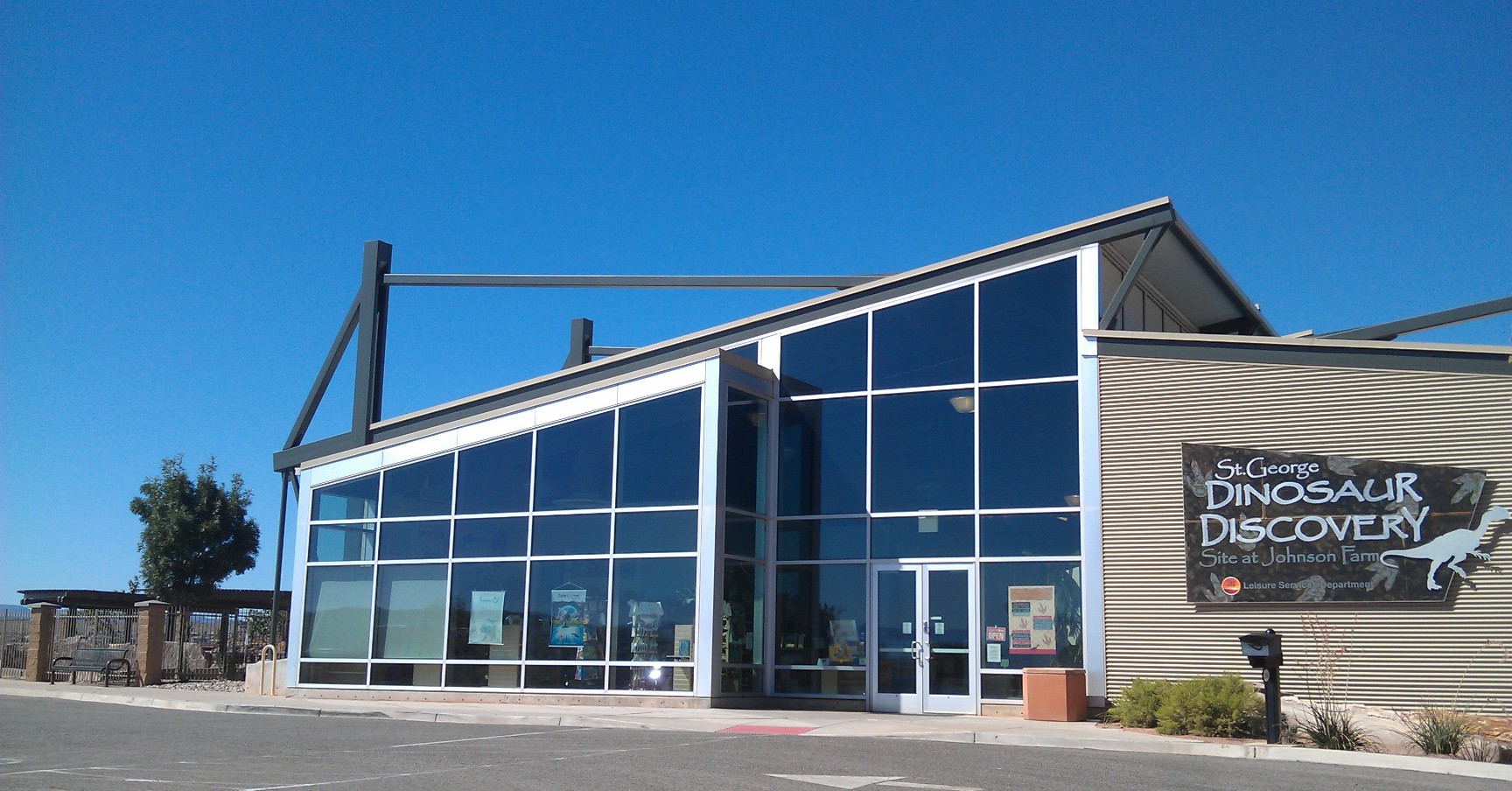
WASHINGTON COUNTY HISTORICAL SOCIETY (Washington County, Utah)
ST. GEORGE DINOSAUR DISCOVERY SITE AT JOHNSON FARM
(aka DINOSAUR TRACKS MUSEUM)
St. George, Utah
LOCATION
Dinosaur Tracks MuseumSt. George Dinosaur Discovery Site at Johnson Farm
2180 E. Riverside Drive
St. George, UT 84790
(435)574-3466
http://www.UtahDinosaurs.com
http://www.facebook.com/StGeorgeDinosaurDiscoveryMuseum
tracksofdinos@gmail.com
HISTORY
Dr. Sheldon & Leatrice Johnson bought the land that belonged to Ellis Wilson. Sheldon knew Ellis Wilson when they were boys in Tropic, Utah. Some time about 1960 when Sheldon's five sons were old enough to work, he wanted to find a project for them to work with and learn. Looking around, trying to find a spot where they could create a farm from their own labor, Sheldon found Ellis had accumulated over one hundred acres of land along the Virgin River that had water rights that hadn't been proved up on. So Sheldon went to Ellis and asked if he would sell him some land. Ellis had been working for years trying to prove up on the water right, but did not have the financial backing to get the right equipment to level the ground and use the water. Ellis stood on the ground and waved his hand in general directions, saying, "I think it goes from over there to about over there." They agreed on the sale, but before they could sign their contract, Ellis died of a heart attack. After some time, Sheldon went to Ellis' widow and asked if she still wanted to sell. She said she certainly did. She needed to send her sons on missions.In the meantime, the court had an appraisal done, and they valued the land at $13,000.00. Sheldon and his wife, Leatrice, agreed to pay Mrs. Wilson $25,000.00 which was the price Ellis and Sheldon had discussed. Sheldon made the offer on the condition that he could pay $2,500.00 down and the balance at $150.00 a month at 6% interest. She agreed, and a contract was made. To square up the property for a hay field, the Johnsons later bought eighteen acres from Rulon Foster and six acres from Tone Foremaster. The land where dinosaur tracks were found was just over the line on the Rulon Foster property, but within one hundred feet of the Wilson property. The larger hill south of the site and most of the rest of Sheldon's farm was from the Wilsons. If the Wilsons had not sold Sheldon the farm, he never would have made the dinosaur discovery.
The Johnson family developed a 65-acre alfalfa field. But in early 2000 while leveling a hill on his property that hadn't been part of the alfalfa fields, Sheldon came to a thick sandstone layer and happened to flip over one of the sandstone blocks. He noted the trace fossils hidden there. Further exploration uncovered amazing casts of dinosaur feet or negative footprints. And then the whirlwind frenzy of discovery overtook the Johnsons and St George! The Spectrum published a great article and word of the discovery started to spread. Worldwide television broadcasts and newspaper articles have made these artifacts world famous and now are visited by thousands of people, as recently witnessed by Ripley's "Believe It or Not."
Paleontologists and volunteers flocked to the area to record Sheldon's amazing find. It was all under the open sky. Several tents were eventually set up but it was apparent something more was needed. The priceless trace fossils that were now exposed to the elements needed to be protected. Utah's State Paleontologist Dr. James Kirkland, track specialist Dr. Martin Lockley, and others declared them to be the finest examples of late Triassic/early Jurassic dinosaurs foot impressions ever found.
Protecting the trace fossils wasn't the only immediate need. In those early days as many as 5 school buses could be on site at one time and with no hands-on science/learning facility in this area of Utah, a museum to interpret what was being discovered was even more important. In the first ten months of 2001, over 100,000 students, tourists, media, and science specialists had come from across the state of Utah, from all fifty states, and over fifty countries and expressed the need to protect and preserve these artifacts, and teach people about this amazing find.
In the beginning, the burden fell most heavily on the Johnsons, who received calls from University science departments, tour bus companies, and people from around the nation about accessing the site. The Johnsons also built a shade structure and a mist system in an effort to mitigate suffering of volunteers and visitors. The city helped fence the area, provided info sheets, brought water during the hot summer, and supplied an emergency outdoor toilet.
But all that was about to change. The Johnsons and the DinosaurAH!torium Foundation received an unsolicited donation from the Swanson Family Foundation and a One-Time State Funding project that made it possible to find matching grants from many sources to fund the building of a museum to house the trace fossils. In 2005, after tireless efforts, a building was placed right over the top of the find. St George City ran the museum with an advisory board and the non-profit DinosaurAH!torium Foundation. So that was the beginning of the dino museum here in St George.
In 2010 the DinosaurAH!torium Foundation took over the daily operation of the museum. When the foundation took over, they began adding displays and changing exhibits more frequently. The foundation also built a much better prep lab facility.
In 2016, the Foundation nearly doubled the exhibit space by building a boardwalk out over the trackway surface. The boardwalk was completed in May and is known as the Lake Dixie Discovery Trail. Prior to the boardwalk, museum visitors had to imagine the tracks discussed on the signs and by tour guides. They were able to make a few cast replicas but its not the same as being able to meander over the track surface and see sections of the exhibit that still need to be excavated.
The St. George Dinosaur Discovery Site is a thriving museum with over 40,000 annual visitors. Real research is being carried on at the site. And there are many things planned for the future.
PHOTOS

WCHS-03160 Photo of the St. George Dinosaur Tracks Museum at Johnson Farm
Other WCHS photos:
WCHS-03161 Photo of a model of a dinosaur at the Dinosaur Tracks Museum
WCHS-03162 Photo of petrified dinosaur tracks at the Dinosaur Tracks Museum
WCHS-03163 Photo of Dr. Sheldon B. & LaVerna B. Johnson at the Dinosaur Tracks Museum
REFERENCES
Sheldon Johnson Remembers the Dinosaur Site and the Farm HistoryWritten August 2002 at the Request of Kerry Bate, Director of Community Development,
State of Utah Division of Community and Economic Development
St George Dinosaur Discovery Site at Johnson Farm
A PowerPoint presentation by Diana Azevedo, Executive Director
given at the DASIA Brown Bag program on November 25, 2016.
(Large file - may take a while to load).